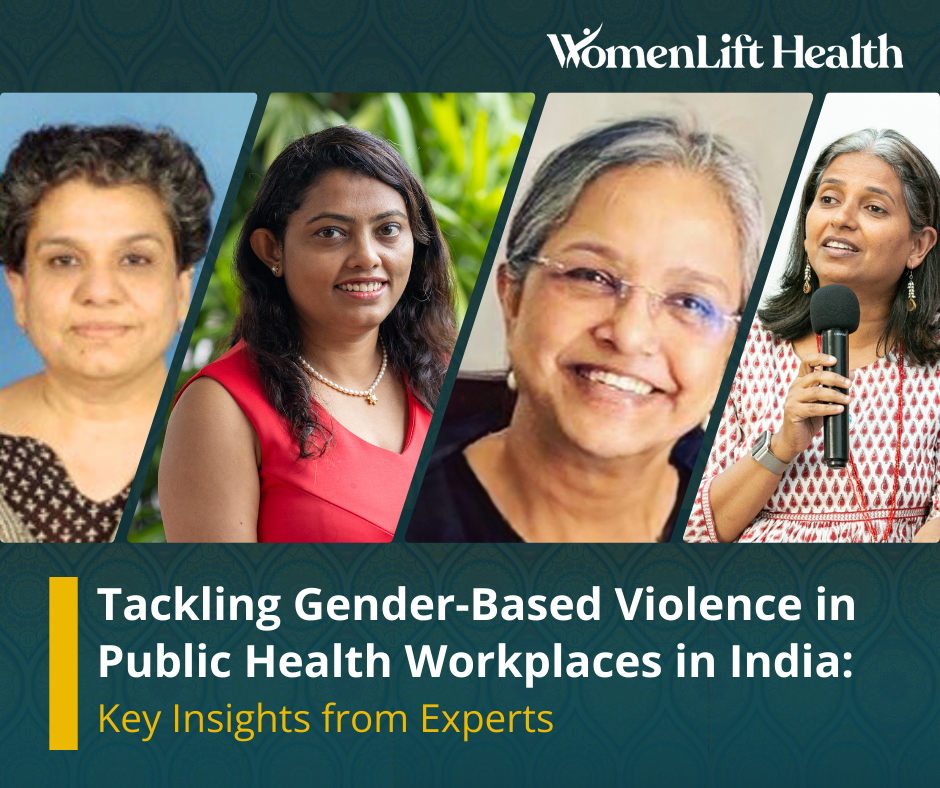Women in India’s public health sector frequently encounter various forms of gender-based violence (GBV), ranging from overt acts of harassment and assault to more unseen, systemic issues like workplace discrimination and biased recruitment practices. These challenges persist despite existing frameworks, often due to a lack of holistic institutional policies as well as deeply rooted societal norms and structural inequalities.
On December 6, WomenLift Health hosted a webinar on Tackling Gender-Based Violence in Public Health Workplaces in India, featuring insights from WomenLift Health India Leadership Journey mentor Manisha Gupte, Founder, Mahila Sarvangeen Utkarsh Mandal (MASUM), WomenLift Health 2024 India Leadership Journey Cohort Members Dr. Monalisha Sahu and Priya Das, and India Alumnae Lead Shubha Nagesh ‘22. The conversation highlighted the multifaceted nature of GBV ranging from microaggressions to sexual harassment, and examined its far-reaching impacts on women’s safety, career progression, and workplace culture.
Broadening the Definition of Gender-Based Violence
Priya Das emphasized that GBV is often understood in its most visible forms, such as physical or sexual assault. However, it is crucial to recognize less visible, systemic forms of violence embedded in workplace practices that often “create the conditions in which these extreme forms of violence take place.” Broadening the definition of GBV beyond physical forms of violence to emotional, psychological, and economic violence against an individual due to their gender, Priya emphasized that these micro-aggressions often manifest in everyday workplace interactions.
A workplace environment that becomes susceptible to more overt violence against women often lacks “gender-responsive infrastructure,” Priya remarked. This includes a lack of adequate restrooms for female healthcare professionals, poor lighting, and inadequate facilities that reflect structural neglect of women’s specific needs. These issues are compounded by lack of safeguards for women who speak out and report instances of sexual harassment at the workplace, often facing a backlash for it, as well as stringent workplace hierarchies that limit women’s career opportunities. Addressing GBV requires confronting these covert forms alongside more overt instances: “To understand gender-based violence, we must understand the continuum of where it begins and eventually where it ends up. Rather than really looking at the symptoms, it’s important that we start addressing the causal roots of it.”
Challenging Gendered Career Barriers and Microaggressions
Dr Monalisha Sahu highlighted how microaggressions and occupational segregation shape career trajectories in public health. Women in medicine, despite being qualified, often face implicit biases discouraging them from pursuing certain careers as well as leadership roles. In some cases, hospitals avoid hiring women due to concerns about maternity leave and childcare responsibilities, reflecting gendered hiring practices. Limited mentorship opportunities further marginalize women, confining them to junior or supportive roles despite equal or superior qualifications to their male counterparts. “There is a vertical occupational segregation because of which, globally, 70% of the health workers are women. So, healthcare is being delivered by women but led by men,” Dr Sahu summarised.
This persistent segregation limits women’s opportunities for advancement and perpetuates workplace inequities. Dr Sahu also noted that microagressions against women in healthcare settings are often brushed under the carpet as ‘professional banter,’ contributing to a deep-rooted culture of silence among colleagues. She reiterated the need for clearer policies, enforcement of existing ones, and a safe space as well as mental health support for survivors of workplace gender-based violence.
Breaking the Public-Private Divide in Workplaces
Manisha Gupte explored how societal norms dividing private and public spheres reinforce workplace discrimination. “Life being artificially divided into the private and the public domain is one of the major structural reasons why women suffer discrimination and violence both inside and outside the house,” she noted. “This allows public and private patriarchies to seemingly act independently, but work together to disenfranchise women everywhere they go, including the workspace.”
The caregiving burden, additionally, often falls disproportionately on women, exacerbated by work-from-home setups. Gendered roles often result in women dropping out of the workforce for several years and if they return, their careers are marked by an erraticism due to expectations to continue to perform caregiving responsibilities alongside work. Workspaces are, therefore, Manisha notes, thought to ‘belong’ to men. Community health workers, particularly those operating in rural areas, face additional challenges such as unsafe travel conditions, lack of protective policies, and exposure to harassment during field visits. Manisha stressed that when women are viewed as outsiders in professional settings, instances of violence serve as another reason to perpetuate gender inequities. “If we don’t take care of safety, the first thing that happens is to take women out of education and the workforce.”
Towards Inclusive Leadership and Workplace Policies
Institutions and policies play a crucial role in combating workplace GBV. Speakers emphasized that while having legal frameworks such as the Prevention of Sexual Harassment (POSH) Act is essential, effective implementation remains a challenge. Organizations must ensure policies are not just on paper but actively enforced through transparent grievance redressal mechanisms, regular training sessions, and strong accountability measures.
Preventing GBV in public health workplaces requires leadership rooted in principles of inclusivity and accountability. “The implementation of POSH has a clear link to leadership,” noted Priya. “We need more leaders and more women leaders to be gender responsive.”
Speakers emphasized that effective leaders must champion gender equity, create safe spaces for dialogue, build robust reporting mechanisms, and ensure that anti-GBV policies are not only well-crafted but also actively enforced. Transparent grievance mechanisms, coupled with proactive training in gender inclusivity and diversity, can help cultivate a culture where misconduct is addressed swiftly and fairly.


